NCERT Solutions | Class 11 Chemistry Chapter 6 | Thermodynamics

CBSE Solutions | Chemistry Class 11
Check the below NCERT Solutions for Class 11 Chemistry Chapter 6 Thermodynamics Pdf free download. NCERT Solutions Class 11 Chemistry were prepared based on the latest exam pattern. We have Provided Thermodynamics Class 11 Chemistry NCERT Solutions to help students understand the concept very well.
NCERT | Class 11 Chemistry
| Book: | National Council of Educational Research and Training (NCERT) |
|---|---|
| Board: | Central Board of Secondary Education (CBSE) |
| Class: | 11th |
| Subject: | Chemistry |
| Chapter: | 6 |
| Chapters Name: | Thermodynamics |
| Medium: | English |
Thermodynamics | Class 11 Chemistry | NCERT Books Solutions
NCERT Exercises
NCERT Solutions for Class 11 Chemistry Chapter 6, Question 1.
(a) used to determine heat changes
(b) whose value is independent of path
(c) used to determine pressure volume work
(d) whose value depends on temperature only.
Solution.
(b): State function is a property of the system whose value depends only upon the state of the system and is independent of the path or the manner by which the state is reached.NCERT Solutions for Class 11 Chemistry Chapter 6, Question 2.
(a) ΔT = 0
(b) Δp = 0
(c) g = 0
(d) w=0
Solution.
(c): Adiabatic system does not exchange heat with the surroundings.NCERT Solutions for Class 11 Chemistry Chapter 6, Question 3.
(a) unity
(b) zero
(c) <0
(d) different for each element.
Solution.
(b) : By convention, the standard enthalpy of formation of every element in its standard state is zero.NCERT Solutions for Class 11 Chemistry Chapter 6, Question 4.
(a) = ΔU°
(b) >ΔU°
(c) <ΔU°
(d) =0
Solution.
(c) : CH4(g)+2O2 → CO2(g)+2H2OlΔn = 1 – 3 = -2. ‘
ΔH° = ΔU° + ΔnRT = -X- 2RT
NCERT Solutions for Class 11 Chemistry Chapter 6, Question 5.
(a) -74.8 kJ mol-1
(b) -52.27 kJ mol-1
(c) +74.8 kJ mol-1
(d) +52.26 kJ mol-1
Solution.

NCERT Solutions for Class 11 Chemistry Chapter 6, Question 6.
(a) possible at high temperature
(b) possible only at low temperature
(c) not possible at any temperature
(d) possible at any temperature
Solution.
(d): A + B → C + D + q, ΔS = +veHere, ΔH = -ve
ΔG = ΔH – TΔS
For reaction to be spontaneous, ΔG should be -ve. As ΔH = -ve and ΔS is +ve, ΔG will be -ve at any temperature.
NCERT Solutions for Class 11 Chemistry Chapter 6, Question 7.
Solution.
Heat absorbed by the system (q) = 701 JWork done by the system (w) = -394 J
According to first law of thermodynamics,
ΔU = q + w = 701 + (-394) = 701 – 394 = 307 J
NCERT Solutions for Class 11 Chemistry Chapter 6, Question 8.
NH2CN(g) + \(\frac { 3 }{ 2 } { O }_{ 2(g) }\) → N2+CO2(g)+H2Ol
Solution.
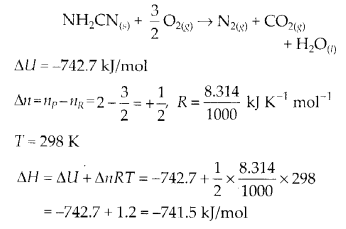
NCERT Solutions for Class 11 Chemistry Chapter 6, Question 9.
Solution.
Mass of Al = 60 gRise in temperature, ΔT = 55 – 35 = 20°C
Molar heat capacity of Al = 24 J mo-1 K-1
Specific heat capacity of Al = \(\frac { 24 }{ 27 } J{ g }^{ -1 }{ K }^{ -1 }\)
∴ Energy required = m x c x ΔT
= \(60\times \frac { 24 }{ 27 } \times 20=\frac { 28800 }{ 27 } =1066.67\quad J\)
= 1.068kJ or 1.07kJ
NCERT Solutions for Class 11 Chemistry Chapter 6, Question 10.
Cp[H2O(l)] = 75.3 J mol-1 K-1,
Cp[H2O(s)] = 36.8 J mol-1 K-1
Solution.
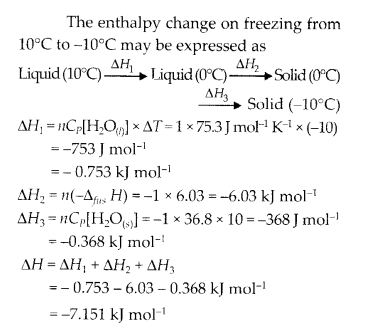
NCERT Solutions for Class 11 Chemistry Chapter 6, Question 11.
Solution.
C + O2 → CO2; ΔT = -393.5 kJ∵ When 44 g of COz is formed from carbon and dioxygen gas, heat released = 393.5 kj
∴ When 35.2 g of CO2 is formed from carbon and dioxygen gas, heat released
= \(\frac { 393.5\times 35.2 }{ 44 } =\frac { 138551.2 }{ 44 } =314.8kJ\)
Thus, ΔH = -314.8 kJ
NCERT Solutions for Class 11 Chemistry Chapter 6, Question 12.
N2O4(g) + 3CO(g) → N2O(g) + 3CO2(g)
Solution.

NCERT Solutions for Class 11 Chemistry Chapter 6, Question 13.
Solution.
N2(g) + 3H2(g) → 2NH3(g) ; ΔrH° = -92.4 kJ mol-1∴ Standard enthalpy of formation of NH3(g)
= \(\frac { -92.4 }{ 2 } =\quad -46.2\quad kJ/mol\)
NCERT Solutions for Class 11 Chemistry Chapter 6, Question 14.
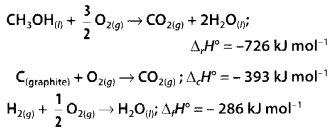
Solution.
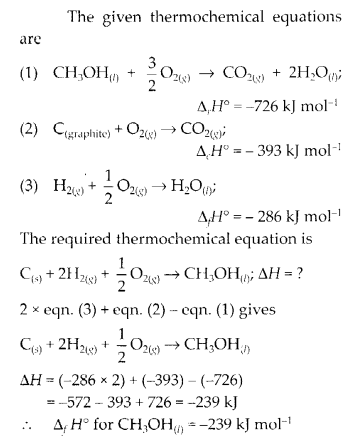
NCERT Solutions for Class 11 Chemistry Chapter 6, Question 15.
CCl4(g) → C(g) + 4Cl(g)
and calculate bond enthalpy of C – Cl in CCl4(g).
ΔvapH°(CCl4) = 30.5 kJ mol-1,
ΔfH°(CCl4) = -135.5 kJ mol-1,
ΔaH°(C) = 715.0 kJ mol-1, where ΔaH° is enthalpy of atomisation ΔaH°(Cl2) = 242 kJ mol-1
Solution.
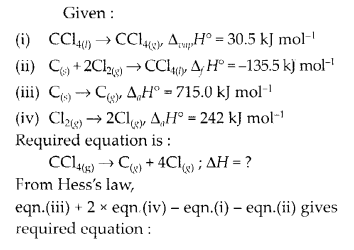
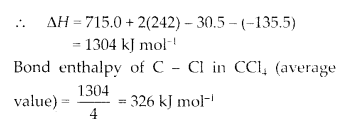
NCERT Solutions for Class 11 Chemistry Chapter 6, Question 16.
Solution.
When energy factor has no role to play, for the process to be spontaneous ΔS must be +ve i.e., ΔS > 0.NCERT Solutions for Class 11 Chemistry Chapter 6, Question 17.
ΔH = 400 kJ mol-1 and ΔS = 0.2 kJ K-1 mol-1 At what temperature will the reaction become spontaneous considering ΔH and ΔS to be constant over the temperature range.
Solution.
According to Gibbs Helmholtz equation, ΔG = ΔH – TΔS.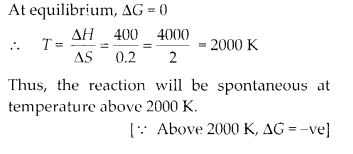
NCERT Solutions for Class 11 Chemistry Chapter 6, Question 18.
Solution.
ΔH is negative because bond energy is released and ΔS is negative because there is less randomness among the molecules than among the atoms.NCERT Solutions for Class 11 Chemistry Chapter 6, Question 19.
2A(g) + B(g) → 2D(g), ΔU° = -10.5 kJ and ΔS° = – 44.1 JK-1.
Calculate ΔG° for the reaction, and predict whether the reaction may occur spontaneously.
Solution.
ΔH° = ΔU° + Δn(g)RT
NCERT Solutions for Class 11 Chemistry Chapter 6, Question 20.
R = 8.314J K-1 mol-1, T= 300 K.
Solution.
We know that ΔG° = – 2.303RT logK= – 2.303 x 8.314 x 300 x log10
= – 5744.14 J/mol
NCERT Solutions for Class 11 Chemistry Chapter 6, Question 21.

Solution.
Since Δ(r)H° is +ve, i.e., enthalpy of formation of NO is positive, therefore NO is unstable. But Δ(r)H° is negative for the formation of NO2. So, NO2 is stable.NCERT Solutions for Class 11 Chemistry Chapter 6, Question 22.
Δ(r)H° = – 286 kJ mol-1.
Solution.
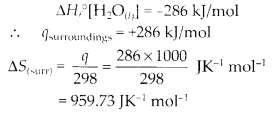
NCERT Class 11 Chemistry
Class 11 Chemistry Chapters | Chemistry Class 11 Chapter 6
Chapterwise NCERT Solutions for Class 11 Chemistry
-
NCERT Solutions For Class 11 Chemistry Chapter 1 Some Basic Concepts of Chemistry
NCERT Solutions For Class 11 Chemistry Chapter 2 Structure of The Atom
NCERT Solutions For Class 11 Chemistry Chapter 3 Classification of Elements and Periodicity in Properties
NCERT Solutions For Class 11 Chemistry Chapter 4 Chemical Bonding and Molecular Structure
NCERT Solutions For Class 11 Chemistry Chapter 5 States of Matter
NCERT Solutions For Class 11 Chemistry Chapter 6 Thermodynamics
NCERT Solutions For Class 11 Chemistry Chapter 7 Equilibrium
NCERT Solutions For Class 11 Chemistry Chapter 8 Redox Reactions
NCERT Solutions For Class 11 Chemistry Chapter 9 Hydrogen
NCERT Solutions For Class 11 Chemistry Chapter 10 The sBlock Elements
NCERT Solutions For Class 11 Chemistry Chapter 11 The pBlock Elements
NCERT Solutions For Class 11 Chemistry Chapter 12 Organic Chemistry: Some Basic Principles and Techniques
NCERT Solutions For Class 11 Chemistry Chapter 13 Hydrocarbons
NCERT Solutions For Class 11 Chemistry Chapter 14 Environmental Chemistry
| NCERT Solutions for Class 12 All Subjects | NCERT Solutions for Class 10 All Subjects |
| NCERT Solutions for Class 11 All Subjects | NCERT Solutions for Class 9 All Subjects |

Post a Comment
इस पेज / वेबसाइट की त्रुटियों / गलतियों को यहाँ दर्ज कीजिये
(Errors/mistakes on this page/website enter here)